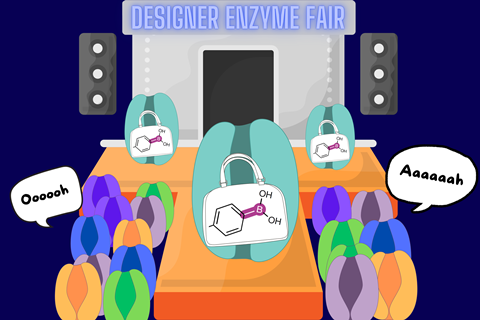
Researchers in Groningen have built a variant of boric acid into an enzyme, a first in the world of designer enzymes. This makes it possible to carry out non-natural reactions in a ‘natural’ way, they write in Nature.
Enzymes come in all shapes and sizes, which makes them useful in a wide range of chemistry, including many synthetic applications. But there are limits. Reactions based on the element boron, for example, are out of reach. At least until now.
‘Boron has been somewhat neglected. It offers unique chemical possibilities and is quite abundant on Earth, but mostly trapped in minerals and rocks and therefore not very accessible. No natural enzyme contains boron’, says research leader Gerard Roelfes, Professor of Biomolecular Chemistry & Catalysis at the University of Groningen. ‘Boron chemistry and catalysis enable reaction mechanisms that you don’t find in nature.’ To exploit these possibilities in a new way, Roelfes’ group has now produced a designer enzyme in which they have genetically encoded a boric acid.
Boron enzyme
This ‘boron enzyme’ can carry out boron chemistry in a more sustainable way, says Roelfes. ‘Because of milder reaction conditions, such as water as a solvent and lower reaction temperatures, biocatalysis with enzymes is much greener than classical organic chemistry.’ But green chemistry is not the only reason why boron enzymes are interesting. ‘Enzymes are amazing catalysts. The catalytic site provides more control, faster reactions and great stereoselectivity. Conventional boron catalysis has almost no examples of stereoselectivity, so with our enzyme you can actually do something new.’
Although incorporating boric acid was relatively straightforward – ‘we’ve been doing this for years’ – the biggest challenge was finding a suitable model reaction. ‘There are many possible boric acid reactions, but the catalytic site is limiting’, explains Roelfes. For example, the reaction must also be able to work in water at low temperatures and not interact with other functional groups on the enzyme itself. ‘You also have to find the right position in the protein. We are getting better at this, but each new designer enzyme is an adventure in itself.’
Directed evolution
The researchers inserted the non-canonical amino acid para-boronophenylalanine into a designer enzyme. This boronic acid group catalyses the stereoselective condensation reaction of α-hydroxyketones with hydroxylamine to form an oxime. Roelfes: ‘The reaction proceeds with what is known as kinetic resolution, which means that you start with a racemic mixture of your substrate, from which one enantiomer is then selectively converted.’
They used MS and 11B-NMR – ‘a strong feat from postdoctoral researcher Lars Longwitz’ – to confirm that this is indeed a boric acid reaction mechanism that doesn’t occur anywhere in nature. The first authors, Longwitz and Reuben Leveson-Gower, then used directed evolution to optimise the boronic acid enzyme, making it highly selective.
The potential of enzymes for organic synthesis continues to amaze Roelfes. ‘I am trained as a classical organic chemist and learned that you use water for extractions, and nothing else. But when you find the right parameters, there’s so much chemistry you can do under such mild conditions. Chemistry that you wouldn’t expect to be possible in water. So don’t be too quick to think in terms of absolutes, it often turns out that there are ways of doing things differently.’
Possibilities
This first boron enzyme is mainly a proof of principle, but it is an important first step. ‘It allows us to find out what the enzyme can do, how you can activate it and how you can then translate it into other important reactions’, says Roelfes. ‘For example, there are still whole classes of reactions for the pharmaceutical industry that cannot be done with enzymes, such as nucleophilic aromatic substitution or cross-coupling.’
Of course, if you can do it with boron, there must be many more possibilities. Roelfes: ’Compared to the bipyridines and anilines that we started with, putting boron into an enzyme is really a big step away from nature. If you look at the periodic table, there are still a lot of elements I would like to study. We’re playing around with it, but I want to be able to do useful chemistry with it eventually, it shouldn’t become a trick. If you can find new reactions that can only be done with these kinds of designer enzymes, then there must be some interesting applications too.’
Longwitz, L., Leveson-Gower, R.B. et al. (2024) Nature, DOI: 10.1038/s41586-024-07391-3












Nog geen opmerkingen